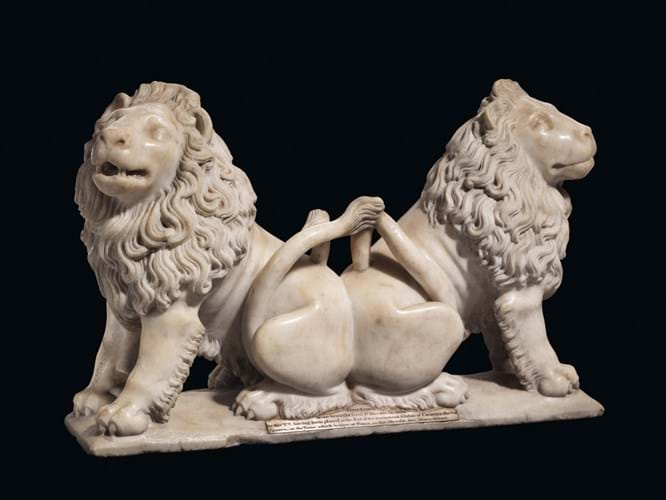
Last June, Christie’s sold a pair of medieval marble mourning figures from the tomb of the Duc de Berry to the Louvre for €4.4m (£3.67m) plus premium at its sculpture sale in Paris.
They are looking to repeat their success again this year having secured a second pair of medieval tomb sculptures, made around 50 years earlier, in this case a pair of lions from the funerary monument of Charles V of France, the Duc de Berry’s brother. The lions have been in the same English family for over 200 years, since they were acquired in France by the English aristocrat Sir Thomas Neave.
The lions are to be offered in the auctioneers’ Exceptional sale in London on July 6 and expectations are that they could make at least as much as the mourners.
The finely carved 11.5in (29cm) high addorsed figures of seated lions would have been placed at the feet of the king’s effigy which was one of a group of four family tombs commissioned by the young Charles V for the Basilica of Saint Denis. The church in the northern suburb of Paris, is the burial place for nearly all of the Kings of France.
Charles commissioned his funerary monuments from André Beauneveu (c.1335-1402) one of the pre-eminent sculptors of late medieval Europe. Beauneveu and his workshop took two years from 1364-66 to complete the tomb groups but scholars think that the figure of Charles was the only one executed entirely by his own hand.
Saved by Archaeologist
Like many of the royal tombs at Saint Denis. Charles V’s monument was dismantled in 1793 during the Revolution. It is not known when the lions became separated from the king’s effigy, which has now been restored to St Denis. The archaeologist Alexandre Lenoir created a museum of French monuments during the upheavals of the Revolution which included Charles’ tomb effigy and we know from 19th century records that items were sold, probably to fund the museum.
Sir Thomas Neave is known to have visited France in 1802 during the Napoleonic wars and the lions may have been acquired at that point via this route.
“They are really fantastic,” says Christie’s sculpture specialist Donald Johnston who said: “I’ve known of them for over 20 years and I was always hoping that one day the owner would decide to sell.”
It is only now with their appearance on the market that the lions have come into the public domain, hitherto being known to scholars only through an 18th century engraving and drawing. The drawing, says Johnston, shares distinctive similarities with the marbles notably the detail of the way the tails curl up around the hind leg of each lion.
But the clincher, adds Johnston, who has been to St Denis to see the effigy “is that the marble is identical and the polishing is identical and on the reverse of the lions are the remains of two little dowels that fit into the effigy. I’ve measured both and they are exactly the same distance apart”.
Prior to their sale in July, Christie’s will be taking the lions on tour to exhibit them in April in New York and in Hong Kong in May.





